Evaluating the Energy Resources and Environmental Impacts for Blueberry Packaging Materials with a Focus on End-of-Life Scenarios
Abstract
1. Introduction
1.1. Research Background
1.2. Literature Review
1.3. Research Goal and Hypothesis
2. Materials and Methods
2.1. Research Methodology
- Packaging 1: cardboard package (CB);
- Packaging 2: cardboard package with a cellulose lid (CBC);
- Packaging 3: polypropylene (PP);
- Packaging 4: rice straw package covered with a lid made from polylactic acid (RPLA) as a bio-based plastic.
2.2. Life Cycle Assessment Method
2.3. Examination Methods for Transport Processes
- The transportation of raw materials (kraft paper, wood, polypropylene granulate, and PLA) to the production stage (by truck, Euro 6, with a gross weight of 26–28 tons);
- Transport between the production and use stages (truck trailer, Euro 6, with a gross weight of 34–40 tons);
- Transport between the use and end-of-life stages (truck trailer, Euro 6, with a gross weight of 34–40 tons).
3. Results
- Scenario 1 (SC1): recycling (R);
- Scenario 2 (SC2): composting (C);
- Scenario 3 (SC3): landfilling (D);
- Scenario 4 (SC4): incineration (I).
3.1. Environmental Impacts for Recycling (SC1)
- -
- In the case of CB packaging, the mixed recovered paper component was fully recycled as a secondary raw material in the production phase. The mixed recovered paper component and, thus, the recycled amount constituted 84% of the total paper weight of the packaging material produced. The bleached kraft paper component (16%) was conventionally incinerated as waste paper. The wastewater generated during production was treated in a municipal wastewater treatment plant.
- -
- In the case of CBC packaging, the mixed recovered paper component was fully recycled as a secondary raw material in the production phase. It constituted 84% of the weight of the packaging material produced. The bleached kraft paper and cellulose foil components were disposed of in a conventional incinerator.
- -
- In the case of PP packaging, PP was recycled as a secondary raw material into the production process as an input stream at a rate of 100%. The lid of this packaging material consisted of PET (9% of the total weight), which was conventionally incinerated.
- -
- In the case of RPLA packaging, 90% was recycled as a secondary raw material for production from the main components, recycled paper and PLA, and the remaining 10% was incinerated.
3.2. Environmental Impacts for Composting (SC2)
3.3. Environmental Impacts for Landfilling (SC3)
3.4. Environmental Impacts for Incineration (SC4)
3.5. Global Warming Potential of Life Cycle Stages
3.6. Sensitivity Analysis and Weak Point Analysis for EoL Scenarios
- RPLA packaging consistently shows the lowest carbon footprint across all EoL scenarios, which may be due to its lightweight, recyclable, and partially compostable nature.
- Recycling always leads to a lower CF than incineration or landfilling, with the difference being particularly significant for CBC, where there is a saving of 37 kg CO2 equation. Compared to incineration, it is achieved for 1000 kg of berry packaging.
- PP packaging is more sensitive to changes in the EoL scenario, as its carbon footprint for incineration is more than 2.5 times higher than that of the recycling option (269.2 vs. 109.6 kg CO2 equation).
- Type CBC (2) behaves unfavorably in non-recycling scenarios, as its carbon footprint exceeds 190–280 kg CO2 equation for composting, landfilling, and incineration.
3.7. Total Environmental Impacts of Packaging Materials
3.8. Embodied Energy of Packaging Materials
4. Discussion and Conclusions
- Blueberries stored in CB and CBC packaging had higher soluble solids than the control;
- Instrumentally measured color intensity was higher in RPLA compared to other packages;
- The CB packaging’s openings are too wide for blueberries, making them unsafe for transportation and leading to higher weight loss during transportation,
- The cellulose lid of the CBC packaging had some deformations after storage. Cellophane has an even higher energy requirement and is not recyclable. Energy requirements can be reduced by using renewable energy sources or recycled paper, which means a 50–70% reduction in CO2 emissions. Reusable alternatives are more expensive and more energy-intensive due to increased transportation and cleaning costs based on the Confederation of European Paper Industries (CEPI) [53]. The European Paper Recycling Council’s (EPRC’s) recycling target is 76% for the 2021–2030 European Declaration [54].
Author Contributions
Funding
Data Availability Statement
Conflicts of Interest
References
- Zhao, L.; Sun, W.; Zhao, L.; Zhang, L.; Yin, Y.; Zhang, Y. Neofusicoccum Vaccinii: A Novel Species Causing Stem Blight and Dieback of Blueberries in China. Plant Dis. 2022, 106, 2338–2347. [Google Scholar] [CrossRef]
- Krishna, P.; Pandey, G.; Thomas, R.; Parks, S. Improving Blueberry Fruit Nutritional Quality through Physiological and Genetic Interventions: A Review of Current Research and Future Directions. Antioxidants 2023, 12, 810. [Google Scholar] [CrossRef] [PubMed]
- Oh, E.; Kim, Y.; Park, S.; Lim, Y.; Shin, J.; Kim, J.Y.; Kim, J.-H.; Rhee, M.-Y.; Kwon, O. The Fruit of Acanthopanax Senticosus Harms Improves Arterial Stiffness and Blood Pressure: A Randomized, Placebo-Controlled Trial. Nutr. Res. Pract. 2020, 14, 322. [Google Scholar] [CrossRef]
- Stote, K.S.; Wilson, M.M.; Hallenbeck, D.; Thomas, K.; Rourke, J.M.; Sweeney, M.I.; Gottschall-Pass, K.T.; Gosmanov, A.R. Effect of Blueberry Consumption on Cardiometabolic Health Parameters in Men with Type 2 Diabetes: An 8-Week, Double-Blind, Randomized, Placebo-Controlled Trial. Curr. Dev. Nutr. 2020, 4, nzaa030. [Google Scholar] [CrossRef]
- Nanak Dev Negi. Blueberry Cultivation-Indian Perspective, 1st ed.; Negi, N.D., Ed.; AkiNik Publications: Delhi, India, 2025; ISBN 978-93-6135-633-9. [Google Scholar]
- Zhang, C.; Guo, Q.; Liu, Y.; Liu, H.; Wang, F.; Jia, C. Molecular Cloning and Functional Analysis of a Flavanone 3-Hydroxylase Gene from Blueberry. J. Hortic. Sci. Biotechnol. 2017, 92, 57–64. [Google Scholar] [CrossRef]
- International Blueberry Organization (IBO). Global State of the Blueberry Industry Report 2024; International Blueberry Organization (IBO): El Dorado Hills, CA, USA, 2024. [Google Scholar]
- Food and Agriculture Organization of the United Nations FAOSTAT. Available online: https://www.fao.org/statistics/en (accessed on 18 June 2025).
- Sasaki, Y.; Orikasa, T.; Nakamura, N.; Hayashi, K.; Yasaka, Y.; Makino, N.; Shobatake, K.; Koide, S.; Shiina, T. Optimal Packaging for Strawberry Transportation: Evaluation and Modeling of the Relationship between Food Loss Reduction and Environmental Impact. J. Food Eng. 2022, 314, 110767. [Google Scholar] [CrossRef]
- Marsh, K.; Bugusu, B. Food Packaging—Roles, Materials, and Environmental Issues. J. Food Sci. 2007, 72, R39–R55. [Google Scholar] [CrossRef]
- Directive (EU) 2019/904 of the European Parliament and of the Council of 5 June 2019 on the Reduction of the Impact of Certain Plastic Products on the Environment; EU: Brussel, Belgium, 2019.
- Expra. Expra Launch of the Circular Plastics Alliance by Dg Growth. Launch of the Circular Plastics Alliance by Dg Growth. Available online: https://expra.eu/2019/04/25/launch-of-the-circular-plastics-alliance-by-dg-growth/ (accessed on 18 May 2025).
- Geyer, R.; Jambeck, J.R.; Law, K.L. Production, Use, and Fate of All Plastics Ever Made. Sci. Adv. 2017, 3, e1700782. [Google Scholar] [CrossRef]
- Prakritii. Why Is Eco-Friendly Packaging the Future of Food Takeaway in India? Available online: https://prakritii.com/blogs/blog/why-is-eco-friendly-packaging-the-future-of-food-takeaway-in-india (accessed on 18 May 2025).
- OECD Berry Fruits. Available online: https://www.oecd.org/en/publications/2024/06/berry-fruits_df83b357.html (accessed on 18 May 2025).
- Ashique, S.; Mukherjee, T.; Mohanty, S.; Garg, A.; Mishra, N.; Kaushik, M.; Bhowmick, M.; Chattaraj, B.; Mohanto, S.; Srivastava, S.; et al. Blueberries in Focus: Exploring the Phytochemical Potentials and Therapeutic Applications. J. Agric. Food Res. 2024, 18, 101300. [Google Scholar] [CrossRef]
- Wang, J.; Tian, J.; Li, D.; Gao, N.; Deng, J.; Yang, X.; Wang, L.; He, Y.; Li, B.; Wang, L. Blueberry Leaves as a Promising Sustainable Source of Polyphenols: Chemical Composition, Functional Activities and Future Application Perspectives. Food Res. Int. 2025, 207, 116110. [Google Scholar] [CrossRef]
- Ktenioudaki, A.; O’Donnell, C.P.; Emond, J.P.; do Nascimento Nunes, M.C. Blueberry Supply Chain: Critical Steps Impacting Fruit Quality and Application of a Boosted Regression Tree Model to Predict Weight Loss. Postharvest. Biol. Technol. 2021, 179, 111590. [Google Scholar] [CrossRef]
- Pérez, R.; Laca, A.; Laca, A.; Díaz, M. Environmental Behaviour of Blueberry Production at Small-Scale in Northern Spain and Improvement Opportunities. J. Clean. Prod. 2022, 339, 130594. [Google Scholar] [CrossRef]
- Parajuli, R.; Thoma, G.; Matlock, M.D. Environmental Sustainability of Fruit and Vegetable Production Supply Chains in the Face of Climate Change: A Review. Sci. Total Environ. 2019, 650, 2863–2879. [Google Scholar] [CrossRef] [PubMed]
- du Plessis, M.; van Eeden, J.; Goedhals-Gerber, L.L. Energy and Emissions: Comparing Short and Long Fruit Cold Chains. Heliyon 2024, 10, e32507. [Google Scholar] [CrossRef]
- Vu, N.D.; Doan, T.K.L.; Dao, T.P.; Tran, T.Y.N.; Nguyen, N.Q. Soursop Fruit Supply Chains: Critical Stages Impacting Fruit Quality. J. Agric. Food Res. 2023, 14, 100754. [Google Scholar] [CrossRef]
- Cai, Z.; Wang, L.; Zhang, Q.; Yang, W.; Zhang, C.; Wang, H.; Xiao, H. Eco-Friendly Coating Engineered with Antimicrobial Lipopeptides Maintains Freshness and Induces Genes Expression in Anthocyanin Biosynthesis of Blueberry. Int. J. Biol. Macromol. 2025, 306, 141590. [Google Scholar] [CrossRef]
- Dragišić Maksimović, J.; Milivojević, J.; Djekić, I.; Radivojević, D.; Veberič, R.; Mikulič Petkovšek, M. Changes in Quality Characteristics of Fresh Blueberries: Combined Effect of Cultivar and Storage Conditions. J. Food Compos. Anal. 2022, 111, 104597. [Google Scholar] [CrossRef]
- Li, H.; Wang, S.; Chen, J.; Sun, M.; Tang, H. Preparation and Characterization of Thymol-Loaded ZIF-8/κ-Carrangeenan/Zein Composite Film as Active Food Packaging with Enhanced Functional Properties for Blueberry Preservation. Carbohydr. Polym. 2025, 356, 123406. [Google Scholar] [CrossRef]
- Peano, C.; Girgenti, V.; Baudino, C.; Giuggioli, N. Blueberry Supply Chain in Italy: Management, Innovation and Sustainability. Sustainability 2017, 9, 261. [Google Scholar] [CrossRef]
- Peano, C.; Baudino, C.; Tecco, N.; Girgenti, V. Green Marketing Tools for Fruit Growers Associated Groups: Application of the Life Cycle Assessment (LCA) for Strawberries and Berry Fruits Ecobranding in Northern Italy. J. Clean. Prod. 2015, 104, 59–67. [Google Scholar] [CrossRef]
- Bof, M.J.; Laurent, F.E.; Massolo, F.; Locaso, D.E.; Versino, F.; García, M.A. Bio-Packaging Material Impact on Blueberries Quality Attributes under Transport and Marketing Conditions. Polymers 2021, 13, 481. [Google Scholar] [CrossRef] [PubMed]
- Koort, A.; Moor, U.; Põldma, P.; Kaiser, C.; Starast, M. Comparison of Regular Atmospheric Storage versus Modified Atmospheric Packaging on Postharvest Quality of Organically Grown Lowbush and Half-Highbush Blueberries. Sustainability 2018, 10, 3916. [Google Scholar] [CrossRef]
- Giuggioli, N.R.; Girgenti, V.; Briano, R.; Peano, C. Sustainable Supply-Chain: Evolution of the Quality Characteristics of Strawberries Stored in Green Film Packaging. CyTA J. Food 2017, 15, 211–219. [Google Scholar] [CrossRef]
- Singh, A.; Gu, Y.; Castellarin, S.D.; Kitts, D.D.; Pratap-Singh, A. Development and Characterization of the Edible Packaging Films Incorporated with Blueberry Pomace. Foods 2020, 9, 1599. [Google Scholar] [CrossRef] [PubMed]
- Mari, A.; Kekes, T.; Boukouvalas, C.; Krokida, M. Integrating Life Cycle Assessment in Innovative Berry Processing with Edible Coating and Osmotic Dehydration. Foods 2025, 14, 1167. [Google Scholar] [CrossRef]
- Mannheim, V.; Avató, J.L. Life-Cycle Assessments of Meat-Free and Meat-Containing Diets by Integrating Sustainability and Lean: Meat-Free Dishes Are Sustainable. Sustainability 2023, 15, 12014. [Google Scholar] [CrossRef]
- Mannheim, V. Life Cycle Assessment Model of Plastic Products: Comparing Environmental Impacts for Different Scenarios in the Production Stage. Polymers 2021, 13, 777. [Google Scholar] [CrossRef]
- Avató, J.L.; Mannheim, V. Life Cycle Assessment Model of a Catering Product: Comparing Environmental Impacts for Different End-of-Life Scenarios. Energies 2022, 15, 5423. [Google Scholar] [CrossRef]
- SPHERA Life Cycle Assessment (LCA) Software. Available online: https://sphera.com/solutions/product-stewardship/life-cycle-assessment-software-and-data/ (accessed on 18 May 2025).
- CML-Department of Industrial Ecology CML-IA Characterisation Factors. Available online: https://www.universiteitleiden.nl/en/research/research-output/science/cml-ia-characterisation-factors#downloads (accessed on 18 May 2025).
- Guinée, J.B.; Gorrée, M.; Heijungs, R.; Huppes, G.; Kleijn, R.; de Koning, A.; van Oers, L.; Sleeswijk, A.W.; Suh, S.; de Haes, H.A.U.; et al. Handbook on Life Cycle Assessment; Operational Guide to the ISO Standards; I: LCA in Perspective; IIa: Guide; IIb: Operational Annex; III: Scientific Background; Springer: Belin, Germany; Kluwer Academic Publishers: Dordrecht, The Netherlands, 2002; ISBN 1-4020-0228-9. [Google Scholar]
- ISO 14040:2006; Environmental Management—Life Cycle Assessment—Principles and Framework. ISO: Geneva, Switzerland, 2006.
- ISO 14044:2006; Environmental Management—Life Cycle Assessment—Requirements and Guidelines. ISO: Geneva, Switzerland, 2006. Available online: https://www.iso.org/standard/38498.html (accessed on 6 June 2019).
- Camaratta, R.; Volkmer, T.M.; Osorio, A.G. Embodied Energy in Beverage Packaging. J. Env. Manag. 2020, 260, 110172. [Google Scholar] [CrossRef]
- Dixit, M.K. Embodied Energy Calculation: Method and Guidelines for a Building and Its Constituent Materials. Ph.D. Thesis, Office of Graduate and Professional Studies of Texas A&M University, College Station, TX, USA, 2013. [Google Scholar]
- Čekon, M.; Struhala, K.; Slávik, R. Cardboard-Based Packaging Materials as Renewable Thermal Insulation of Buildings: Thermal and Life-Cycle Performance. J. Renew. Mater. 2017, 5, 84–93. [Google Scholar] [CrossRef]
- Zhejiang Shanghe Plastic Rubber Material Co., Ltd. Application of Polypropylene Foam Material; Zhejiang Shanghe Plastic Rubber Material Co., Ltd.: Huzhou, China, 2021. [Google Scholar]
- Rai, P.; Mehrotra, S.; Sharma, S.K. Potential of Sensing Interventions in the Life Cycle Assessment of Fruits and Fruit Juices. Trends Food Sci. Technol. 2024, 151, 104614. [Google Scholar] [CrossRef]
- Galarreta, D. Une Approche Sémiotique Du Contexte Pour Les Systèmes Pervasifs. In Proceedings of the Ergonomie et Informatique Avancee Conference, Bidart, France, 6–8 October 2021; ACM: New York, NY, USA, 2021; pp. 85–92. [Google Scholar]
- Oliver-Villanueva, J.-V.; Armengot-Carbó, B.; Lorenzo-Saéz, E.; Lerma-Arce, V. Sustainable Environmental Analysis of Wooden Boxes for Fruit and Vegetable Packaging and Transport in Comparison with Corrugated Cardboard Boxes. Sustainability 2025, 17, 557. [Google Scholar] [CrossRef]
- Rezvani Ghomi, E.R.; Khosravi, F.; Saedi Ardahaei, A.S.; Dai, Y.; Neisiany, R.E.; Foroughi, F.; Wu, M.; Das, O.; Ramakrishna, S. The Life Cycle Assessment for Polylactic Acid (PLA) to Make It a Low-Carbon Material. Polymers 2021, 13, 1854. [Google Scholar] [CrossRef] [PubMed]
- Madival, S.; Auras, R.; Singh, S.P.; Narayan, R. Assessment of the Environmental Profile of PLA, PET and PS Clamshell Containers Using LCA Methodology. J. Clean. Prod. 2009, 17, 1183–1194. [Google Scholar] [CrossRef]
- Peelman, N.; Ragaert, P.; De Meulenaer, B.; Adons, D.; Peeters, R.; Cardon, L.; Van Impe, F.; Devlieghere, F. Application of Bioplastics for Food Packaging. Trends Food Sci. Technol. 2013, 32, 128–141. [Google Scholar] [CrossRef]
- Almenar, E.; Samsudin, H.; Auras, R.; Harte, B.; Rubino, M. Postharvest Shelf Life Extension of Blueberries Using a Biodegradable Package. Food Chem. 2008, 110, 120–127. [Google Scholar] [CrossRef]
- Almenar, E.; Samsudin, H.; Auras, R.; Harte, J. Consumer Acceptance of Fresh Blueberries in Bio-Based Packages. J. Sci. Food Agric. 2010, 90, 1121–1128. [Google Scholar] [CrossRef] [PubMed]
- CEPI PRELIMINARY 4 European Pulp & Paper Industry. Available online: https://www.cepi.org/cepi-preliminary-statistics-2024 (accessed on 25 May 2025).
- European Paper Recycling Council (EPRC). Monitoring Report 2023; European Paper Recycling Council (EPRC): Brussels, Belgium, 2024. [Google Scholar]
- Jahanshahia, S.S.; Sharafati, A.; Vahidi, H. Carbon Footprint of Polypropylene Product in Iranian Petrochemical Industry. Environ. Energy Econ. Res. 2024, 8, S086. [Google Scholar] [CrossRef]
- Plastics Europe. The Circular Economy for Plastics a European Analysis Executive Summary; Plastics Europe: Brussels Belgium, 2024. [Google Scholar]
- Flizikowski, J.; Kruszelnicka, W.; Macko, M. The Development of Efficient Contaminated Polymer Materials Shredding in Recycling Processes. Polymers 2021, 13, 713. [Google Scholar] [CrossRef]
- Walichnowska, P.; Kruszelnicka, W.; Mazurkiewicz, A.; Kłos, Z.; Rudawska, A.; Bembenek, M. An Analysis of Changes in the Harmfulness of the Bottle Packaging Process Depending on the Type of Heat-Shrinkable Film. Materials 2024, 17, 4115. [Google Scholar] [CrossRef]
- Buri, Z.; Sipos, C.; Szűcs, E.; Máté, D. Smart and Sustainable Energy Consumption: A Bibliometric Review and Visualization. Energies 2024, 17, 3336. [Google Scholar] [CrossRef]
- Danko, G.; Jobbik, A.; Baracza, M.K.; Varga, G.; Kovacs, I.; Wittig, V. Energy Potential of a Single-Fracture, Robust, Engineered Geothermal System. Geomech. Geophys. Geo-Energy Geo-Resour. 2020, 6, 26. [Google Scholar] [CrossRef]

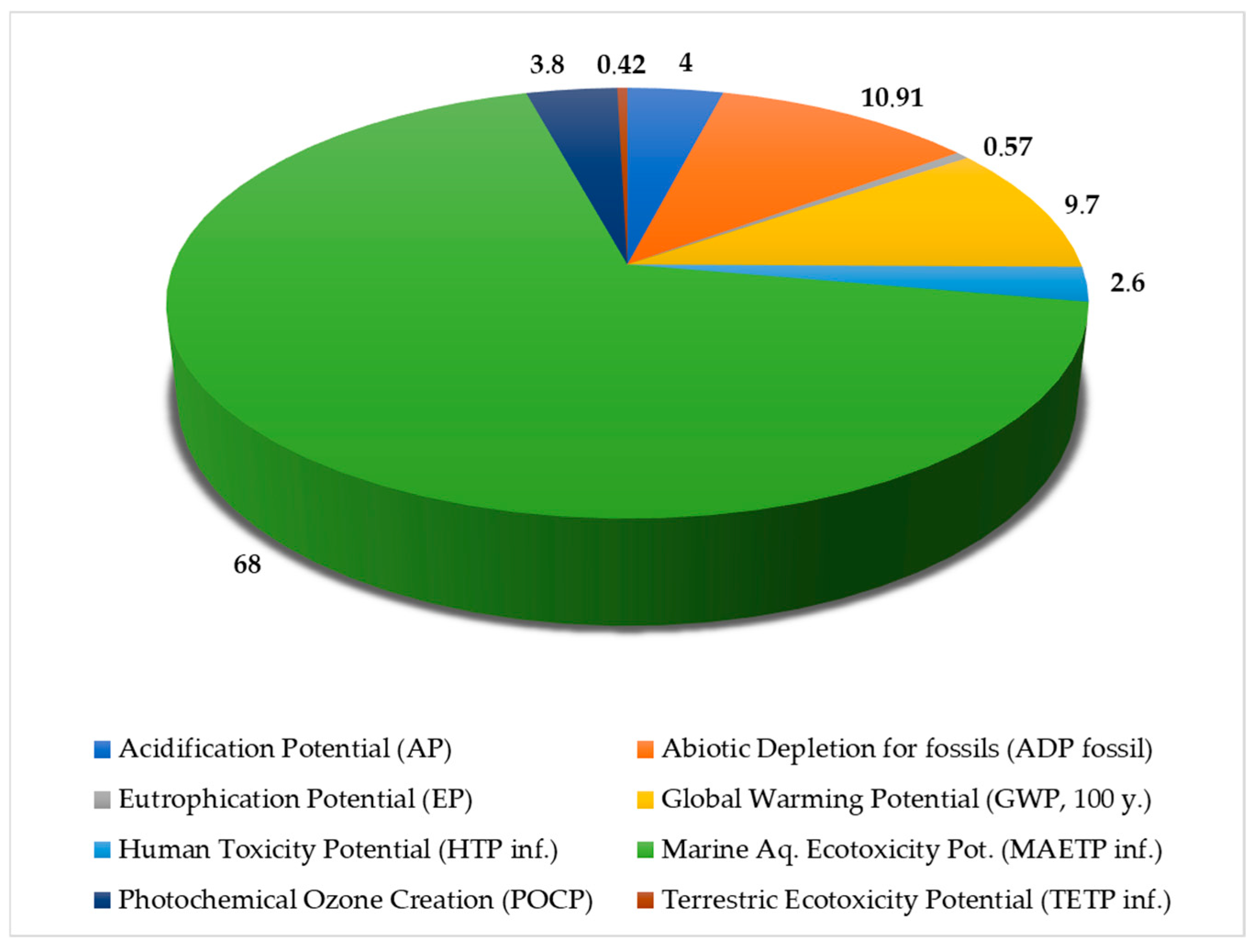
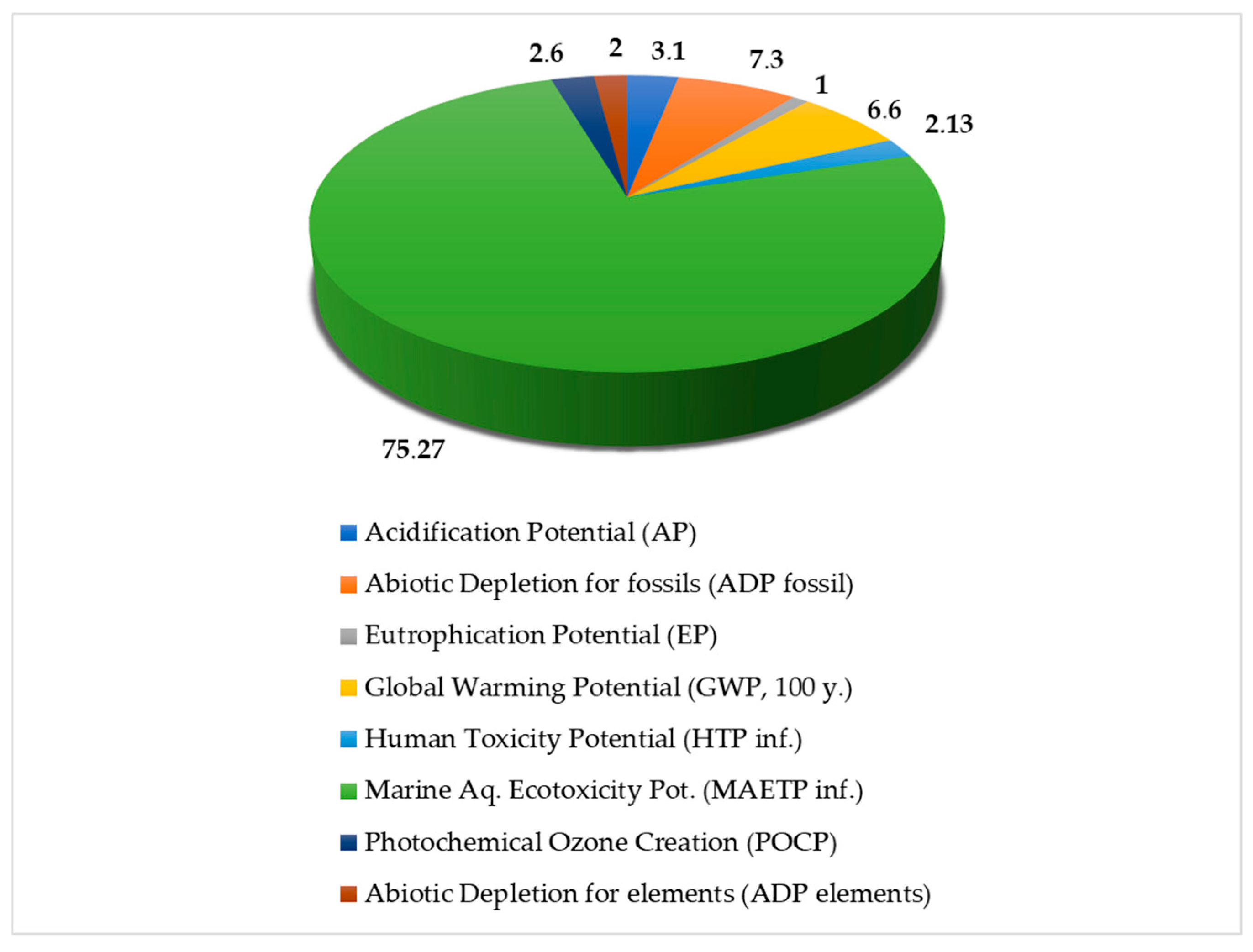


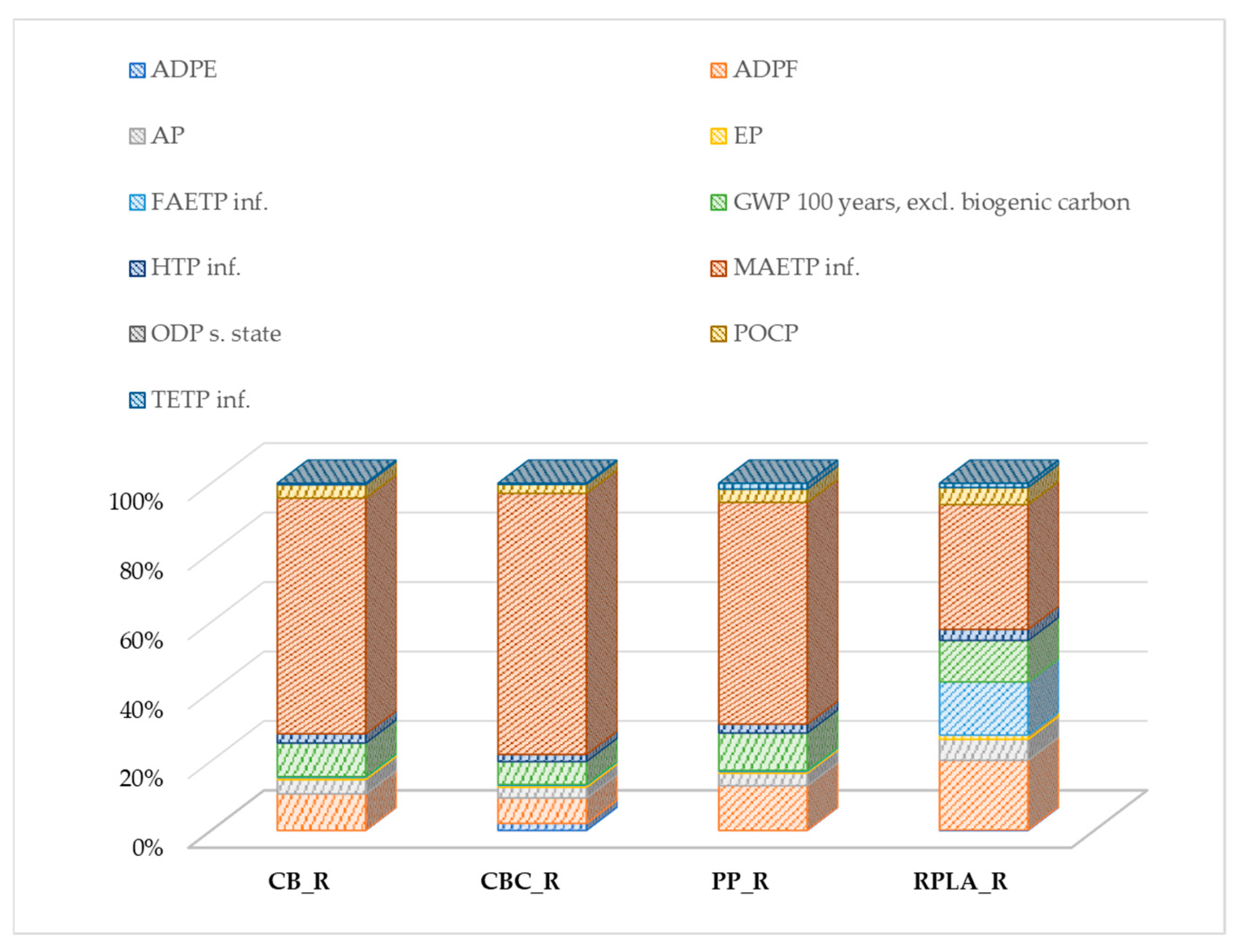



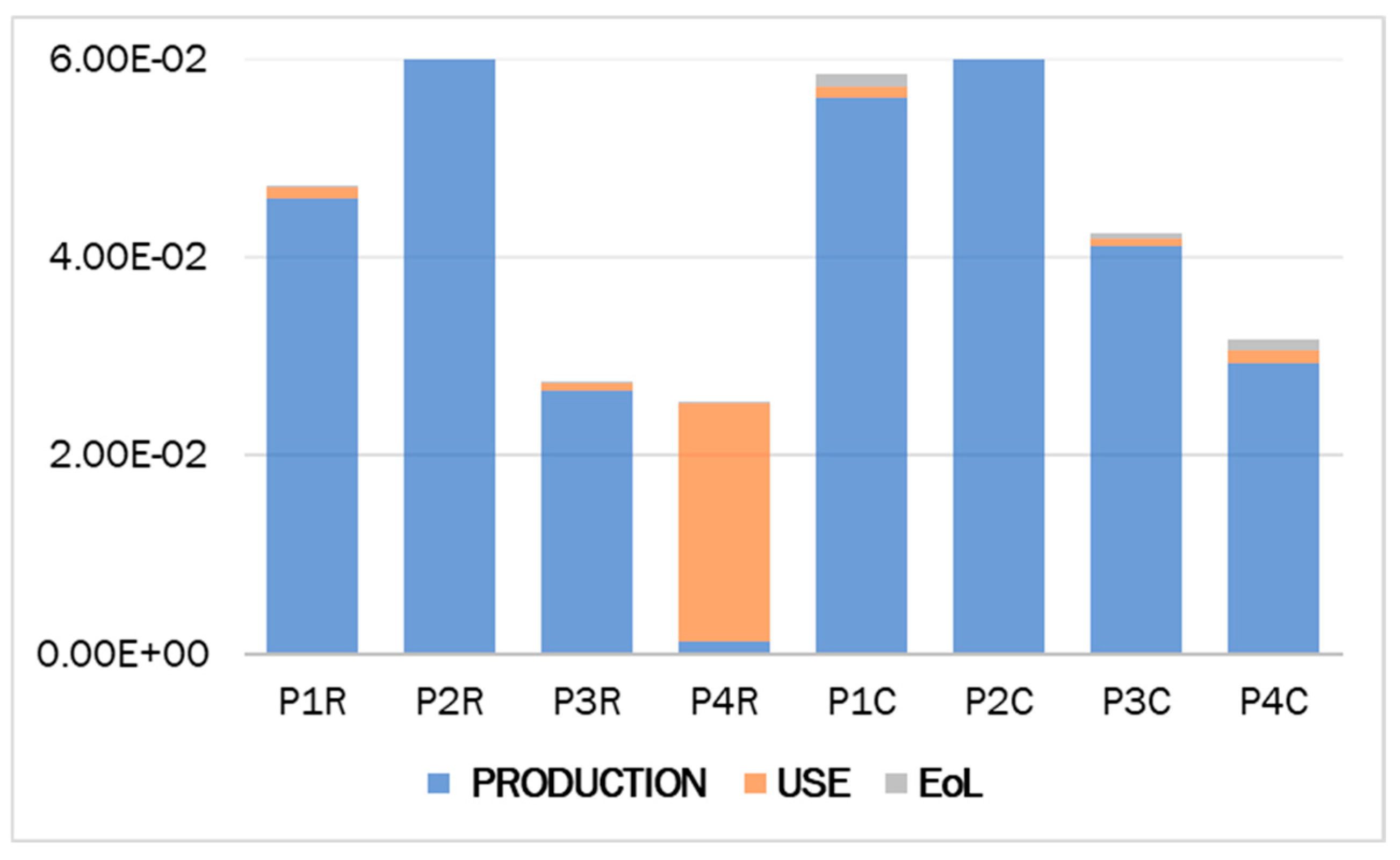
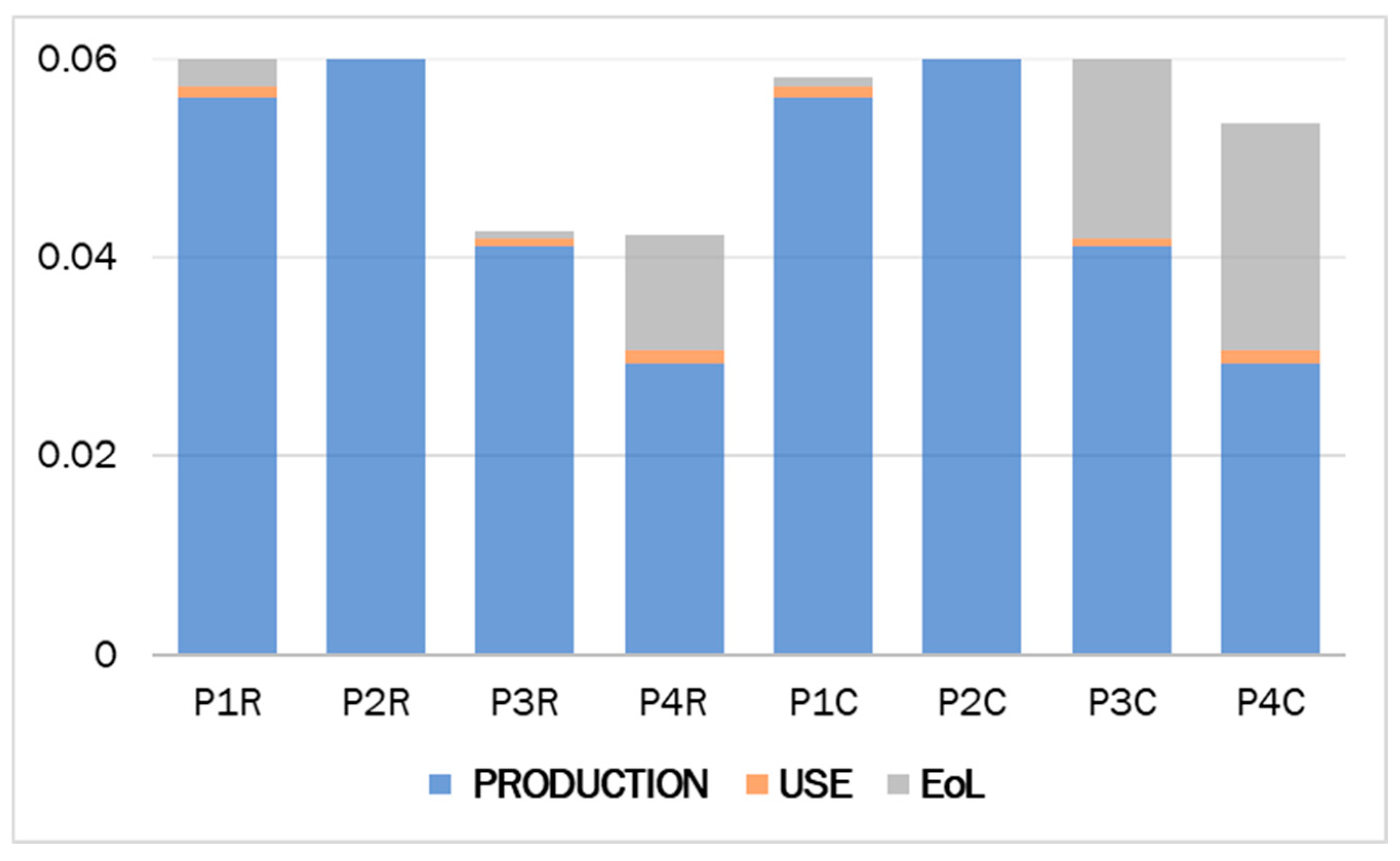
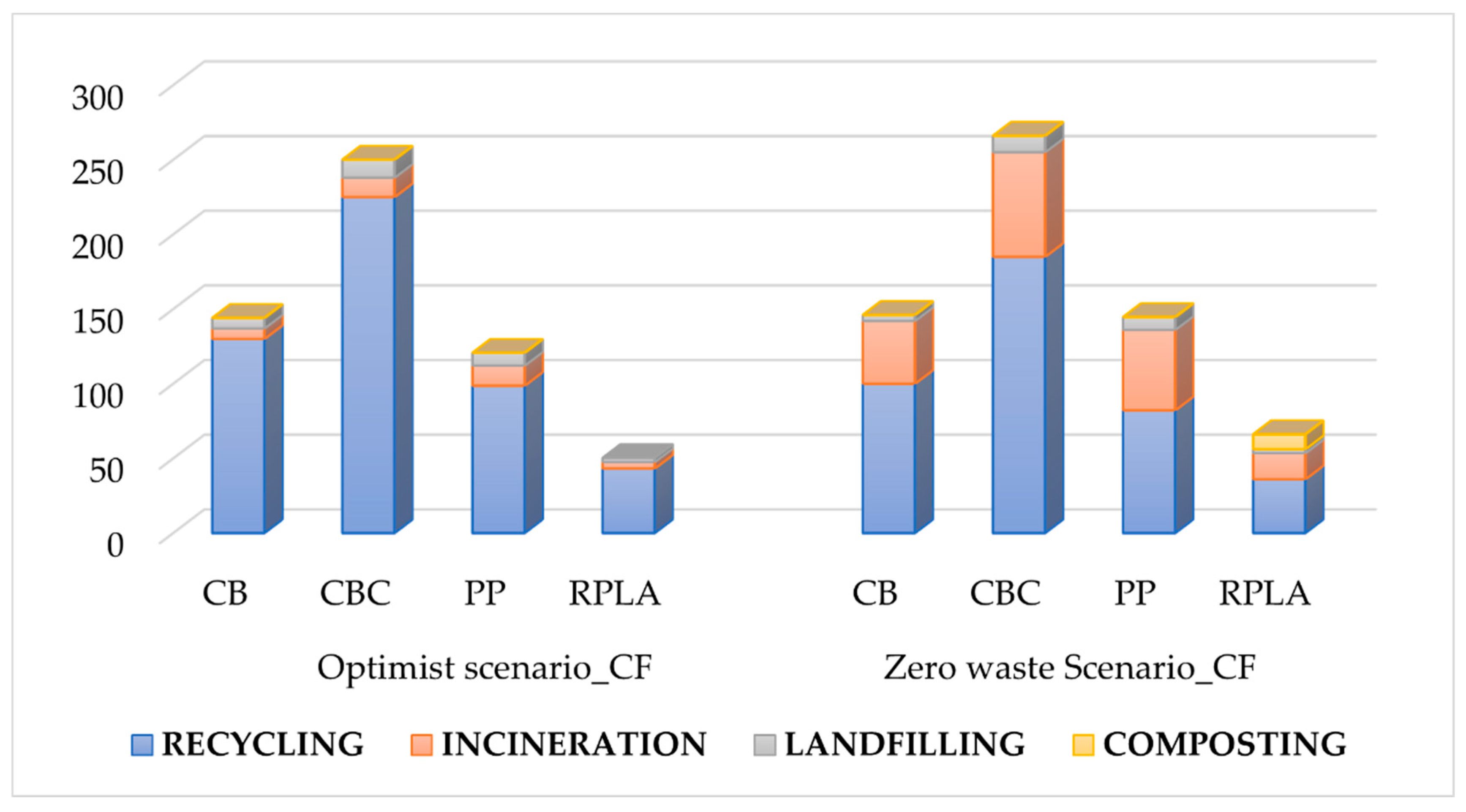


| Short Name of the Packaging Material | Packaging 1 CB | Packaging 2 CBC | Packaging 3 PP | Packaging 4 RPLA |
|---|---|---|---|---|
| Longer name and exact type | Cardboard packaging from rec. paper SoFruPak | Cardboard packaging with cellulose lid SoFruPak | Polypropylene packaging n.a. | Rice straw punnet with PLA lid Bio4Pack |
| Weight without lid [g] | Produced without lid | 22.36 | 6.26 | 11.46 |
| Weight with lid [g] | 23.41 | 32.36 | 11.41 | 18.37 |
| Number of aeration holes | 18 | 10 | 22 | 10 |
| Environmental Impact Quantities for Cradle-to-Cradle LCA (LCIA Method: CML 2016) | Packaging 1 CB 0.023 kg | Packaging 2 CBC 0.032 kg | Packaging 3 PP 0.011 kg | Packaging 4 RPLA 0.018 kg |
|---|---|---|---|---|
| Abiotic Depletion ADP elements, ADPE | 1.38 × 10−16 | 3.83 × 10−14 | 6.07 × 10−17 | 4.49 × 10−16 |
| Abiotic Depletion ADP fossils, ADPF | 8.66 × 10−14 | 1.37 × 10−13 | 5.50 × 10−14 | 7.21 × 10−14 |
| Acidification Potential AP | 3.41 × 10−14 | 5.82 × 10−14 | 1.56 × 10−14 | 2.17 × 10−14 |
| Eutrophication Potential EP | 4.68 × 10−15 | 9.90 × 10−15 | 1.92 × 10−15 | 4.44 × 10−15 |
| Fresh Water A. Ecotoxicity Pot. FAETP inf | 2.24 × 10−15 | 5.12 × 10−15 | 1.42 × 10−15 | 5.51 × 10−14 |
| Global Warming Pot. GWP 100 years | 7.96 × 10−14 | 1.24 × 10−13 | 4.61 × 10−14 | 4.28 × 10−14 |
| Human Toxicity Potential HTP inf. | 2.17 × 10−14 | 3.84 × 10−14 | 1.10 × 10−14 | 1.16 × 10−14 |
| Marine A. Ecotox. Pot. MAETP inf. | 5.59 × 10−13 | 1.41 × 10−12 | 2.73 × 10−13 | 1.29 × 10−13 |
| Ozone Layer Depletion Pot. ODP s.state | 3.40 × 10−20 | 3.61 × 10−20 | 2.66 × 10−23 | 1.64 × 10−18 |
| Photochem. Ozone Creat. Pot. POCP | 3.16 × 10−14 | 4.85 × 10−14 | 1.64 × 10−14 | 1.77 × 10−14 |
| Terrestric Ecotoxicity Pot. TETP inf. | 3.49 × 10−15 | 5.80 × 10−15 | 7.17 × 10−15 | 4.41 × 10−15 |
| Total | 8.23 × 10−13 | 1.87 × 10−12 | 4.28 × 10−13 | 3.59 × 10−13 |
| Environmental Impact Quantities (CML 2016) | Packaging 1 CB | Packaging 2 CBC | Packaging 3 PP | Packaging 4 RPLA |
|---|---|---|---|---|
| Abiotic Depletion ADP elements, ADPE | 3.14 × 10−16 | 3.85 × 10−14 | 3.72 × 10−16 | 5.29 × 10−16 |
| Abiotic Depletion ADP fossils, ADPF | 1.09 × 10−13 | 1.68 × 10−13 | 1.49 × 10−13 | 8.38 × 10−14 |
| Acidification Potential AP | 4.54 × 10−14 | 7.39 × 10−14 | 1.26 × 10−14 | 2.69 × 10−14 |
| Eutrophication Potential EP | 8.49 × 10−15 | 1.52 × 10−14 | 2.46 × 10−15 | 6.27 × 10−15 |
| Fresh Water A. Ecotoxicity Pot. FAETP inf | 2.14 × 10−14 | 3.17 × 10−14 | 1.45 × 10−14 | 6.97 × 10−14 |
| Global Warming Pot. GWP 100 years | 9.88 × 10−14 | 1.51 × 10−13 | 7.17 × 10−14 | 5.34 × 10−14 |
| Human Toxicity Potential HTP inf. | 6.94 × 10−14 | 1.05 × 10−13 | 3.85 × 10−14 | 4.60 × 10−14 |
| Marine A. Ecotox. Pot. MAETP inf. | 5.88 × 10−13 | 1.45 × 10−12 | 2.89 × 10−13 | 1.36 × 10−13 |
| Ozone Layer Depletion Pot. ODP | 2.04 × 10−19 | 2.72 × 10−19 | 3.65 × 10−22 | 1.73 × 10−18 |
| Photochem. Ozone Creat. Pot. POCP | 4.79 × 10−14 | 7.11 × 10−14 | 3.12 × 10−14 | 2.60 × 10−14 |
| Terrestric Ecotoxicity Pot. TETP inf. | 5.71 × 10−14 | 8.04 × 10−14 | 7.12 × 10−14 | 4.61 × 10−14 |
| Total | 1.05 × 10−12 | 2.18 × 10−12 | 6.81 × 10−13 | 4.95 × 10−13 |
| Environmental Impact Quantities (CML 2016) | Packaging 1 CB | Packaging 2 CBC | Packaging 3 PP | Packaging 4 RPLA |
|---|---|---|---|---|
| Abiotic Depletion ADP elements, ADPE | 3.8 × 10−16 | 3.86 × 10−14 | 4.03 × 10−16 | 5.78 × 10−16 |
| Abiotic Depletion ADP fossils, ADPF | 1.14 × 10−13 | 1.75 × 10−13 | 1.51 × 10−13 | 8.67 × 10−14 |
| Acidification Potential AP | 5.07 × 10−14 | 8.13 × 10−14 | 1.47 × 10−14 | 3.06 × 10−14 |
| Eutrophication Potential EP | 1.23 × 10−14 | 2.05 × 10−14 | 3.56 × 10−15 | 1.14 × 10−14 |
| Fresh Water A. Ecotoxicity Pot. FAETP inf | 3.53 × 10−15 | 6.92 × 10−15 | 6.06 × 10−15 | 5.6 × 10−14 |
| Global Warming Pot. GWP 100 years | 1.31 × 10−13 | 1.96 × 10−13 | 7.2 × 10−14 | 7.14 × 10−14 |
| Human Toxicity Potential HTP inf. | 3.38 × 10−14 | 5.52 × 10−14 | 2.14 × 10−14 | 1.8 × 10−14 |
| Marine A. Ecotox. Pot. MAETP inf. | 6.41 × 10−13 | 1.52 × 10−12 | 3.15 × 10−13 | 1.74 × 10−13 |
| Ozone Layer Depletion Pot. ODP | 2.04 × 10−19 | 2.72 × 10−19 | 3.66 × 10−22 | 1.73 × 10−18 |
| Photochem. Ozone Creat. Pot. POCP | 7.27 × 10−14 | 1.06 × 10−13 | 3.25 × 10−14 | 3.91 × 10−14 |
| Terrestric Ecotoxicity Pot. TETP inf. | 5.82 × 10−15 | 9.04 × 10−15 | 4.7 × 10−14 | 6.48 × 10−15 |
| Total | 1.07 × 10−12 | 2.21 × 10−12 | 6.64 × 10−13 | 4.94 × 10−13 |
| Environmental Impact Quantities (CML 2016) | Packaging 1 CB | Packaging 2 CBC | Packaging 3 PP | Packaging 4 RPLA |
|---|---|---|---|---|
| Abiotic Depletion ADP elements, ADPE | 3.91 × 10−16 | 3.86 × 10−14 | 4.06 × 10−16 | 6.03 × 10−16 |
| Abiotic Depletion ADP fossils, ADPF | 1.12 × 10−13 | 1.71 × 10−13 | 1.50 × 10−13 | 8.61 × 10−14 |
| Acidification Potential AP | 5.07 × 10−14 | 8.13 × 10−14 | 1.48 × 10−14 | 3.24 × 10−14 |
| Eutrophication Potential EP | 9.70 × 10−15 | 1.69 × 10−14 | 2.99 × 10−15 | 7.45 × 10−15 |
| Fresh Water A. Ecotoxicity Pot. FAETP inf | 3.45 × 10−15 | 6.80 × 10−15 | 5.98 × 10−15 | 5.57 × 10−14 |
| Global Warming Pot. GWP 100 years | 9.82 × 10−14 | 1.50 × 10−13 | 1.13 × 10−13 | 9.02 × 10−14 |
| Human Toxicity Potential HTP inf. | 3.36 × 10−14 | 5.49 × 10−14 | 2.14 × 10−14 | 1.85 × 10−14 |
| Marine A. Ecotox. Pot. MAETP inf. | 6.25 × 10−13 | 1.50 × 10−12 | 3.07 × 10−13 | 1.67 × 10−13 |
| Ozone Layer Depletion Pot. ODP | 2.04 × 10−19 | 2.72 × 10−19 | 3.68 × 10−22 | 1.73 × 10−18 |
| Photochem. Ozone Creat. Pot. POCP | 5.09 × 10−14 | 7.52 × 10−14 | 3.24 × 10−14 | 2.90 × 10−14 |
| Terrestric Ecotoxicity Pot. TETP inf. | 4.80 × 10−15 | 7.62 × 10−15 | 4.62 × 10−14 | 5.44 × 10−15 |
| Total | 9.89 × 10−13 | 2.10 × 10−12 | 6.94 × 10−13 | 4.92 × 10−13 |
| Carbon Footprint (CF) [kg CO2 Equation] | Packaging 1 CB | Packaging 2 CBC | Packaging 3 PP | Packaging 4 RPLA |
|---|---|---|---|---|
| Weight kg/piece | 0.02341 | 0.03236 | 0.01141 | 0.01837 |
| Recycling | 136.0 | 246.0 | 109.6 | 48.00 |
| Composting | 234.0 | 194.4 | 200.0 | 127.0 |
| Landfilling | 180.4 | 257.0 | 171.2 | 53.60 |
| Conventional incineration | 199.6 | 283.0 | 269.2 | 87.20 |
| Quantity of packing tools per 1000 kg of blueberries (unit: 250 g) | 1000 | |||
| EoL Scenario Ratios [%] | Baseline | Optimistic | Zero Waste |
|---|---|---|---|
| Functional unit | 1000 kg | ||
| Recycling | 60 | 90 | 75 |
| Composting | 0 | 0 | 0–10 |
| Landfilling | 10 | 5 | 5 |
| Conventional incineration | 30 | 5 | 20 |
| Energy Resources [kg] | Whole Life Cycle | Production Stage | Use Stage | EoL Stage (Recycling) |
|---|---|---|---|---|
| CB 0.02341 kg/piece | 0.02404 | 0.02362 | 0.00038 | 0.00004 |
| CBC 0.03236 kg/piece | 0.03692 | 0.03634 | 0.00053 | 0.00005 |
| PP 0.01141 kg/piece | 0.01324 | 0.01296 | 0.00026 | 0.00002 |
| RPLA 0.01837 kg/piece | 0.01152 | 0.00042 | 0.01107 | 0.00003 |
| Abiotic Fossil Depletion [MJ] | Whole Life Cycle | Production Stage | Use Stage | EoL Stage (Recycling) |
|---|---|---|---|---|
| CB 0.02341 kg/piece | 0.47474 | 0.4570 | 0.0162 | 0.00154 |
| CBC 0.03236 kg/piece | 0.74964 | 0.7250 | 0.0225 | 0.00214 |
| PP 0.01141 kg/piece | 0.30154 | 0.2900 | 0.0108 | 0.00074 |
| RPLA 0.01837 kg/piece | 0.39591 | 0.0177 | 0.3770 | 0.00121 |
| Abiotic Fossil Depletion [%] | Production Stage |
|---|---|
| cardboard, CB | 10.2 |
| cardboard with cellulose, CBC | 7.1 |
| polypropylene, PP | 12.5 |
| rice straw with PLA lid, RPLA | 34.2 |
Disclaimer/Publisher’s Note: The statements, opinions and data contained in all publications are solely those of the individual author(s) and contributor(s) and not of MDPI and/or the editor(s). MDPI and/or the editor(s) disclaim responsibility for any injury to people or property resulting from any ideas, methods, instructions or products referred to in the content. |
© 2025 by the authors. Licensee MDPI, Basel, Switzerland. This article is an open access article distributed under the terms and conditions of the Creative Commons Attribution (CC BY) license (https://creativecommons.org/licenses/by/4.0/).
Share and Cite
Mannheim, V.; Moor, U.; Laumets, L.; Szita, K.T. Evaluating the Energy Resources and Environmental Impacts for Blueberry Packaging Materials with a Focus on End-of-Life Scenarios. Energies 2025, 18, 3232. https://doi.org/10.3390/en18133232
Mannheim V, Moor U, Laumets L, Szita KT. Evaluating the Energy Resources and Environmental Impacts for Blueberry Packaging Materials with a Focus on End-of-Life Scenarios. Energies. 2025; 18(13):3232. https://doi.org/10.3390/en18133232
Chicago/Turabian StyleMannheim, Viktoria, Ulvi Moor, Liina Laumets, and Klára Tóthné Szita. 2025. "Evaluating the Energy Resources and Environmental Impacts for Blueberry Packaging Materials with a Focus on End-of-Life Scenarios" Energies 18, no. 13: 3232. https://doi.org/10.3390/en18133232
APA StyleMannheim, V., Moor, U., Laumets, L., & Szita, K. T. (2025). Evaluating the Energy Resources and Environmental Impacts for Blueberry Packaging Materials with a Focus on End-of-Life Scenarios. Energies, 18(13), 3232. https://doi.org/10.3390/en18133232







